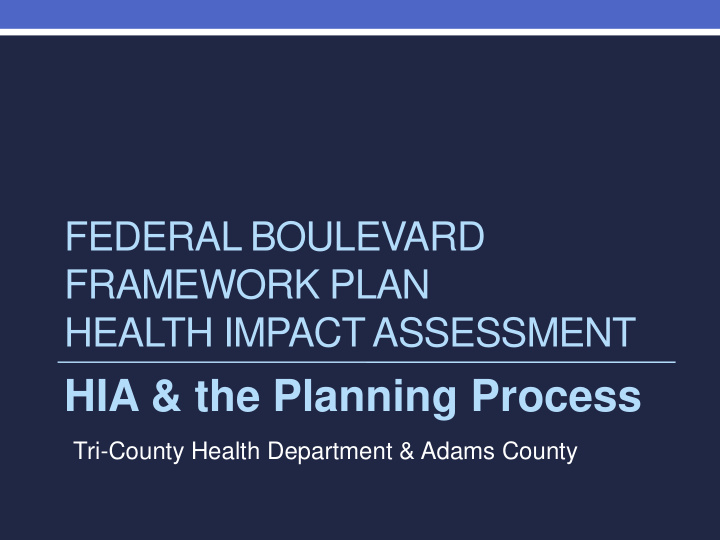



FEDERAL BOULEVARD FRAMEWORK PLAN HEALTH IMPACT ASSESSMENT HIA & the Planning Process Tri-County Health Department & Adams County
Presentation Objectives • The Federal Blvd Framework Plan Overview • The Role of HIA in a Corridor Plan • Understanding of the HIA Process • Integrating HIA: Process, Findings and Recommendations • Lessons Learned
Context for the plan • Southwest Adams County Framework For Future Planning (2005) • Provides foundation for future planning & development • Federal Boulevard corridor identified for future planning efforts
Context for the Plan • Imagine Adams County (2012) • Federal Boulevard – identified as a major commercial corridor • Policies and strategies for revitalizing and expanding role as County gateway
Context for the Plan • Other Planning Efforts & Projects • Berkeley Neighborhood Plan • Clear Creek Valley TOD Plan • Lighting/Median Project • Intersection Improvements (68 th and 60 th ) • Bridge Widening Over Little Dry Creek • Brownfields Area-Wide Planning Grant • Midtown (67 th & Pecos) & ARIA (52 nd & Federal) • Clear Creek Valley Park (Lowell Blvd.) • Future Area Wide Plan (2014-2015)
Goals “Stepping Stone” to Area-Wide Plan ; 1) Begin to understand the complexity and diversity of needs ; 2) Preserve and enhance visual quality of the corridor to 3) create an inviting passage Create safe pedestrian and bike route passages and 4) connections Facilitate vehicular transportation including well- 5) designed and functional connections to stations Provide guidance & recommendations on future economic 6) investments Encourage compatible development 7)
Boundaries
NEIGHBORHOODS
Federal Station • Gold Line Corridor • 60 th Ave. access. • North of BNSF tracks • Parking/bus drop-off • Proposed Clear Creek Transit Village to the west across Federal
Westminster Station • Northwest Corridor • 71 st & Lowell • Terminus till future funding • Open space area to the south
Five-Step Process 1. Project Startup & Approach (January 2014) 2. Inventory & Analysis (February – March 2014) 3. Stakeholder & Community Engagement (March - May 2014) 4. Plan Development and Recommendations (May – July 2014) 5. Adoption (August – September 2014)
INTEGRATING THE HIA INTO THE PROCESS
Tri-County Health Department (TCHD) • Largest local health department in Colorado • Three counties in Metropolitan Denver Region • Serve 1.3 million people • Urban, suburban, rural
TCHD Land Use Program Expanded Program Focus Public Health Objectives • Healthy Community Design • Promote healthy • Healthy Eating Active Living behaviors (HEAL) • Prevent illness and injury • Transportation Planning • Brownfields • Protect against environmental hazards • Health Impact Assessment Partner/Resource
Leading Causes of Death – Adams Co Chronic Lower Heart Unintentional Cancer Stroke Respiratory Disease Injury Disease Some Preventable / Some Preventable / Some Preventable / Some Preventable / Some Preventable / Controllable Risk Controllable Risk Controllable Risk Controllable Risk Controllable Risk Factors Factors Factors Factors Factors • • • • • Physical Tobacco Physical Tobacco Alcohol, Drugs • • • inactivity Obesity inactivity Air pollutants Impaired/ • • • Physical and Distracted Poor nutrition Poor nutrition • • driving Obesity inactivity environmenta Obesity • • • Poor safety • Tobacco Poor nutrition Tobacco l toxins • • awareness • Diabetes Environmental Diabetes • • Risky behaviors High blood toxins • High blood • • Environmenta pressure Cancer-causing pressure • l hazards High viruses (HPV*, • High • Physical cholesterol Hep C) cholestero l • inactivity (fall Sun/UV ray risk in elderly) exposure Potentially addressed through planning process Source: CDPHE, http://www.chd.dphe.state.co.us/Resources/vs/2013/Adams.pdf
What We Did • Community Engagement • Stakeholder interviews • Business Inventory • Ped and Bike Inventory • Walking Audits • Community survey • Community meetings • Existing and Community Data • Literature Review
Planning and HIA Timeline
What We Learned • Existing conditions Percentage of Population Living Below 200% of Poverty Line American Community Survey, 2008-2012
What We Learned • What the community told us • Incomplete and inadequate sidewalks • Limited safe pedestrian crossings • People do not feel safe in the community • People would like to walk more, some do walk, but not enough • Concern about housing cost increases and former landfills/brownfields
What Does This Mean for Health? • Disparities in the Community • Income, Race and Ethnicity, Language, Age Study Area Adams State of County Colorado % Living Below 200% 32.5% - 71.9% 34.3% 29.6% of Poverty Level % Hispanic or Latino 57.1% - 67.1% 37.8% 20.6% (any race) % Speak English Less 16.5% - 31.9% 13.5% 6.7% Than “Very Well” % 65 years of age or 9.0% - 19.1% 8.5% 11.1% older Source: American Community Survey 2008-2012
Health Connections in the Plan • Traffic Safety • Pedestrian Safety • Community Safety • Physical Activity • Housing Affordability
HIA Recommendations Planning Process • Enhance community engagement • Collaboration across jurisdictions • Address transportation issues • Address safety issues
HIA Recommendations Traffic Safety and Physical Activity • Prioritize safe pedestrian and bicycle connections • Develop a plan for pedestrian connections • Improve infrastructure • Safe crossings and sidewalks • Prioritize neighborhood-serving retail, including healthy food retail in land use plans
HIA Recommendations Community Safety • Programs to clean up properties • Prioritize neighborhood-serving retail over sexually-oriented businesses and liquor establishments
HIA Recommendations Housing Affordability • Develop a more actionable recommendation for affordable housing • Preserve existing and prioritize affordability in new development
TCHD’s HIA Program Components • Local government capacity • Resource development • Regional policy development http://oscarmacias.myefolio.com/commassess
HIA Resources • On line Training: http://advance.captus.com/Planning/hia2/home.aspx • HIAs in the US: http://www.healthimpactproject.org/hia/us • HIA Resources (CDC): http://www.cdc.gov/healthyplaces/hiaresources.htm#educat ion
Lesson Learned • Establish expectations • More communication • Education and training
Thank you! Joelle Greenland, AICP Sheila Lynch, AICP Adams County Tri-County Health Department JGreenland@adcogov.org slynch@tchd.org (720) 523-6851 (720) 200-1571
Recommend
More recommend